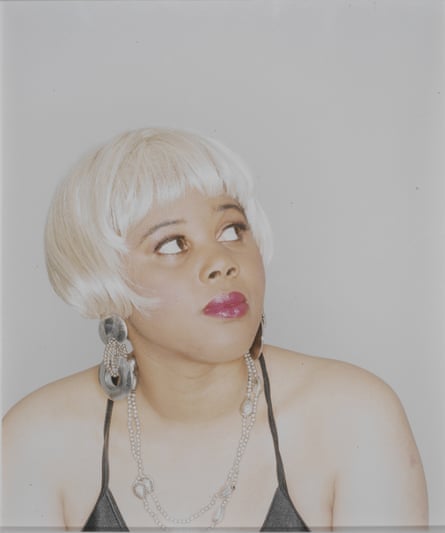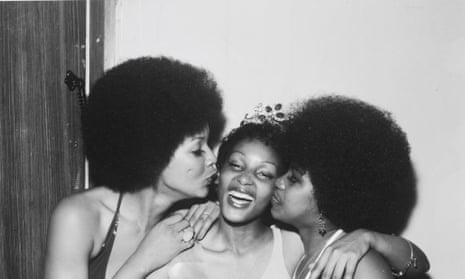The first picture you see as you enter Staying Power: Photographs of Black British Experience 1950s-1990s is Self-portrait in Mirror by Armet Francis. It shows him standing in a small, cluttered room staring down into a camera that’s mounted on a lens. In the background, a young woman gazes up at him in either deep concentration or admiration.
This portrait within a portrait is interesting in all kinds of ways. Francis is black, and the young woman is white. The photograph was taken in 1964, when interracial relationships were still shocking to some. Francis was just 19 when he made it, working as an assistant in a photographic studio in London’s West End. It is a photograph, then, that betokens a degree of self-confidence and belonging, both personal and professional.

Like many of the images in this small, thought-provoking exhibition at the V&A, it is also a glimpse of another country where Jamaican immigrants – Armet Francis arrived here in 1955, aged 10 – were treated with suspicion and, sometimes, animosity, but where an ambitious teenager could nonetheless carve out his place in a London on the cusp of great social and cultural change.
Drawn from a still-fledgling archive built up over the past 17 years by the V&A with the Black Cultural Archives – where an attendant exhibition is also on display – Staying Power combines everything from portraiture to street photography and more self-consciously artistic, but no less personal, approaches to black experience in Britain.
Self-portraiture – or maybe self-camouflage would be a better term – informs the work of both Yinka Shonibare and Maxine Walker. In Shonibare’s celebrated project, Diary of a Victorian Dandy, which stands out here by its scale, colour and ambition, he uses Hogarth’s A Rake’s Progress to explore ideas of outsiderness (and who is more outside than the newly arrived immigrant) through flamboyance and excess.
I was taken by Maxine Walker’s series, Untitled (1995), in which she shoots herself in a range of staged self-portraits – blonde wig, bling and light skin, dreadlocked and “natural” – to question ideas of authenticity, glamour and stereotyping. Made to look like photobooth portraits, they carry a political charge that is both mischievous and provocative. Intriguingly, or problematically, she is utterly transformed each time, alerting us to the power of the cosmetic, the staged and the stylish.
Likewise, Raphael Albert’s photographs of black British beauty pageants in the 1970s, though they belong to another less politically correct time, resonate with their capturing of both glamour and sense of community. In one group portrait, people crowd around a luminously beautiful young woman holding a copy of the soundtrack to The Harder They Come – perhaps a prize? His single portraits are even more haunting for their intimacy: a young woman sits alone in a dark hall, her cherubic face crowned with an afro, while another contestant shows off the ornate rings that decorate every finger of her hands.

Many of the documentary images here, from the likes of Neil Kenlock, Dennis Morris and Norman ‘Normski’ Anderson, have accrued social and historical importance just by everyday experiences they show. Dennis Morris’s portrait of a reggae sound system crew in the 70s is shot in stark monochrome, while Normski uses bright colour to capture a self-styled African homeboy from the hip-hop era a decade later, resplendent in African robes and designer shades. At the Black Cultural Archive in Brixton, Syd Shelton’s images of the Specials fans at a Rock Against Racism carnival in Leeds in 1981 catches another pivotal pop music-fuelled moment in the often turbulent history of British multiculturalism.
Kenlock arrived in Britain from the West Indies in 1963, working as a studio portraitist before becoming a staff photographer for West Indian World, one of the first black British newspapers. He chronicled the British Black Panthers in the early 1970s as well as everyday racism – his portrait of a young black woman standing by a door scrawled with the words “Keep Britain White” carries a charge to this day in its merging of the dignified and the obscene. (It is on show at the BCA exhibition in Brixton). More intimate, though, are his portraits of British West Indians at home, posing proudly with their newly acquired possessions. In one, a young woman sits in front of her TV set framed by gold curtains, the room a dizzying mix of stripes and swirls. In another, a young girl poses with a phone as if speaking to relatives back home. In that single image, the black British experience of exile, pride and tentative belonging is summoned up. Like Armet Francis’s confident self-portrait, it echoes the struggles and hard-won achievements of an entire community. That is the narrative traced in Staying Power, a narrative that, it has to be said, deserves a bigger and more exhaustive exhibition.

Comments (…)
Sign in or create your Guardian account to join the discussion